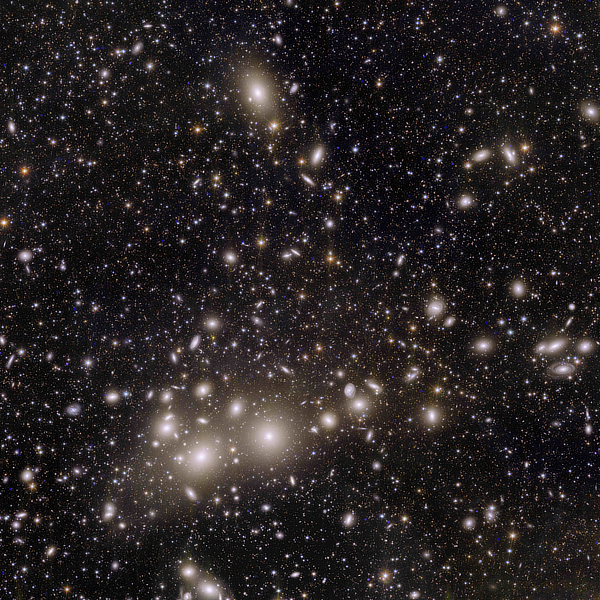NGC 1275 and ACO 426 in Perseus
November 2024 - Galaxy of the Month

I am surprised I have not covered this Abell cluster in Perseus in the GOM series before as it is the standout galaxy cluster in the autumn sky. The cluster lies at a distance of about 240 million light-years from us and is the major component of the Pisces-Perseus super cluster.
This cluster contains thousands of galaxies immersed in a halo of hot X-Ray emitting gas and is believed to be one of the most massive objects in the local universe. The cluster is of the linear type in the Rood-Shastry galaxy cluster classification. This can be seen well in the wide field image from the Euclid satellite. It has an Abell richness class of 2, so it is not regarded as a terribly rich cluster but its closeness to us means there are many galaxies that can be seen ( a richness class of 2 suggests there are between 80 and 129 galaxies in the range m3 to m3+2).
The BCG is the active galaxy NGC 1275 which in deep images shows streams of H-Alpha emission. NGC 1275 is also the Perseus A radio source, the brightest radio source in Perseus. NGC 1275 is at the right-hand side of the cluster along with the other bright galaxies NGC 1272 and NGC 1278. Most of the rest of the galaxies lie along the line to NGC 1250. There are however a couple of bright galaxies that are often missed as they are off the centre line, NGC 1265 and NGC 1282. The total cluster diameter is 17.9’.
The whole Pisces-Perseus cluster stretches perhaps 40 degrees across the sky. An observing guide to the supercluster can be found at Adventures in Deep Space.
Most of the galaxies in Abell 426 appear to be early types (i.e. elliptical and lenticular galaxies) although there are a fair number of spiral galaxies as well. The cluster was also recently shown to contain a large number of low surface brightness dwarf ellipticals. The presence of the spiral galaxies suggests that the cluster is still evolving by accreting local galaxy groups. X-Ray observations suggest that the gas in the cluster is sloshing around generating very low frequency sound waves.
For those interested in future telescopes the following video shows the FOV of the upcoming Nancy Roman telescope compared to Hubble. There is also a recently released image of part of the cluster from the Gemini North telescope.
Although the brighter members of the cluster can be seen with smaller telescopes the cluster really comes into its own when viewed with larger instruments when more than 10 galaxies can be seen in the same field of view when looking at the centre of the cluster. I find that using a medium to high power eyepiece will help bring out the majority of the galaxies in the field and then moving along the main band of the cluster will bring out many more. When looking at the cluster do not forget to view the larger off band galaxies as well.
The cluster is well covered in the Webb Society Deep-Sky Observer's Handbook (WSDSOH) Vol. 5 and makes the Astronomical League clusters of galaxies list as well. There is also a nice report on Cloudy Nights. The cluster is also in Alvin Huey’s Abell clusters guide at FaintFuzzies.com and there is a chart for it in Luginbuhl and Skiff (L&S).
Owen Brazell - Galaxy Section Director